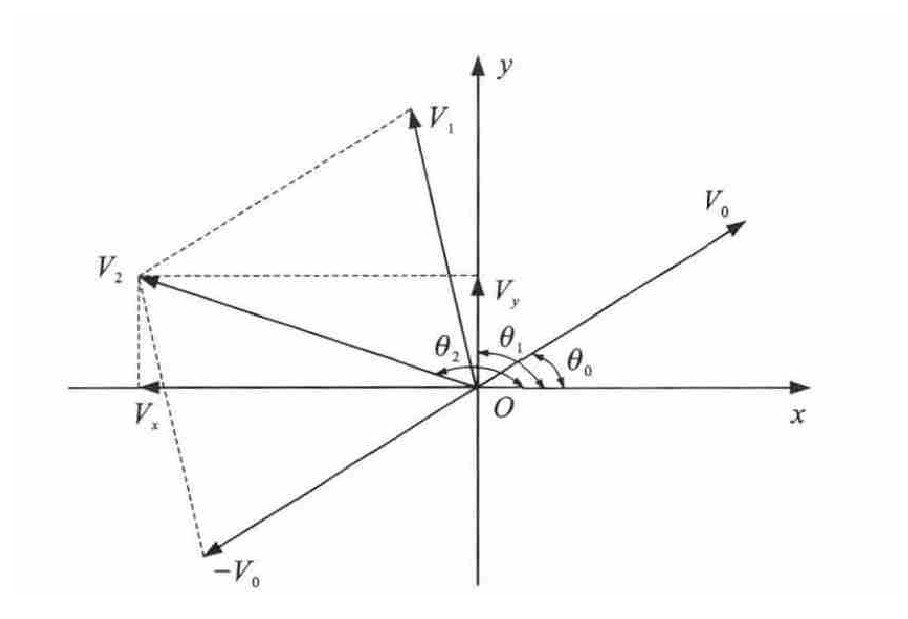Translation control model and optimization method of immersed tube under action of water flow
-
摘要: 针对水流作用下的沉管平移控制问题, 在数学描述的基础上对拖轮合力、合力矩进行了分析, 统一了四象限拖轮力矩的计算公式, 构建了考虑作业拖轮数量、拖力裕量、浮运速度的沉管平移控制优化模型, 提出了基于加权对数理想点法的粒子群优化方法, 运用克拉默法则进行拖力大小和角度的约束处理, 通过港珠澳大桥岛隧工程沉管隧道管节浮运控制算例进行仿真。仿真结果表明: 拖轮总数量为6艘时, 涨潮流情况下所得浮运速度为4.770 kn, 适应度为0.720, 作业拖轮数量为3艘, 拖力裕量乘积为2.693×1020 kN6; 落潮流情况下所得浮运速度为1.750 kn, 适应度为3.042, 作业拖轮数量为5艘, 拖力裕量乘积为3.352×1019 kN6。可见, 本文提出的模型和方法具有较强的适用性, 适应度较优, 作业拖轮数量较小, 拖力裕量与浮运速度较大。Abstract: Aiming at the translation control of immersed tube under the action of water flow, the resultant force and resultant moment of tugboats were analyzed based on the mathematical description, the calculation equations of tug moment in four quadrants were unified, the translation control model of immersed tube was built, and the number of working tugboats, the surplus capacity of towing force and the floating speed were considered.A weighted logarithmic ideal point particle swarm optimization (WLIPPSO) method was designed.Cramer's rule was utilized to handle constraints for towing forces and angles of towing forces.The simulation was carried out through tube floating control example of immersed tube tunnel in island tunnel project of Hong Kong-Zhuhai-Macao Bridge.Simulation result shows that when the total number of tugboats is six, in rising tide the floating speed is 4.770 kn, the fitness is 0.720, the number of working tugboats is three, and the surplus capacity product of towing force is 2.693×1020 kN6.In falling tide the floating speed is 1.750 kn, the fitness is 3.042, the number of working tugboats is five, and the surplus capacity product of towing force is 3.352×1019 kN6.So the model and method proposed have strong applicability, the fitness is better, the number of working tugboats is smaller, surplus capacity of towing force and floating speed are higher.
-
表 1 沉管参数
Table 1. Parameters of immersed tube

表 2 拖轮最大拖力
Table 2. Maximum towing forces of tugboats

表 3 各拖力作用点的坐标
Table 3. Coordinates of towing force points

表 4 各拖力角度的范围
Table 4. Ranges of towing force angles

表 5 涨潮流时WLIPPSO的计算结果
Table 5. Calculation result of WLIPPSO in rising tide

表 6 涨潮流时4种方法的结果对比
Table 6. Results comparison of four methods in rising tide

表 7 落潮流时WLIPPSO的计算结果
Table 7. Calculation result of WLIPPSO in falling tide

表 8 落潮流时4种方法的结果对比
Table 8. Results comparison of four methods in falling tide

-
[1] 傅琼阁. 沉管隧道的发展与展望[J]. 中国港湾建设, 2004(5): 53-58. doi: 10.3969/j.issn.1003-3688.2004.05.017FU Qiong-ge. Development and prospect of immersed tunnels[J]. China Harbour Engineering, 2004(5): 53-58. (in Chinese) doi: 10.3969/j.issn.1003-3688.2004.05.017 [2] LI Wei, FANG Ying-guang, MO Hai-hong, et al. Model test of immersed tube tunnel foundation treated by sand-flow method[J]. Tunnelling and Underground Space Technology, 2014, 40: 102-108. doi: 10.1016/j.tust.2013.09.015 [3] XIAO Long-fei, YANG Jian-min, LI Run-pei. Experimental study on mooring, towing and installing of immersed tunnel caissons[J]. Journal of Shanghai Jiaotong University: Science, 2010, 15(1): 103-107. doi: 10.1007/s12204-010-8705-6 [4] CHEN Ke-qiang, PENG Sheng, WU Wei-guo, et al. Model test of immersed tunnel element in towing tank in winds, waves and currents[C]//ISOPE. Proceedings of the TwentySecond(2012)International Offshore and Polar Engineering Conference. Mountain View: ISOPE, 2012: 831-836. [5] CHERNEVA Z, SOARES C G. Evolution of wave properties during propagation in a ship towing tank and an offshore basin[J]. Ocean Engineering, 2011, 38(17/18): 2254-2261. [6] FITRIADHY A, YASUKAWA H, KOH K K. Course stability of a ship towing system in wind[J]. Ocean Engineering, 2013, 64: 135-145. doi: 10.1016/j.oceaneng.2013.02.001 [7] FITRIADHY A, YASUKAWA H, MAIMUN A. Theoretical and experimental analysis of a slack towline motion on tugtowed ship during turning[J]. Ocean Engineering, 2015, 99: 95-106. doi: 10.1016/j.oceaneng.2015.03.008 [8] 鲍文明. 港作拖轮在大型船舶港内操纵中的使用[J]. 中国航海, 2006(3): 23-26. doi: 10.3969/j.issn.1000-4653.2006.03.007BAO Wen-ming. Application of harbor operational tugs in maneuvering large vessels in port[J]. Navigation of China, 2006(3): 23-26. (in Chinese) doi: 10.3969/j.issn.1000-4653.2006.03.007 [9] NAM T K, JUNG C H, JEONG J S. A study on the calculation of resistance of the ship to be towed and towline tension[J]. Journal of Navigation and Port Research, 2012, 36(8): 607-612. doi: 10.5394/KINPR.2012.36.8.607 [10] NAM T K. A study on the relation between towing force of tow vessel and towing point and behavior of towed ship[J]. Journal of the Korean Society of Marine Environment and Safety, 2013, 19(6): 637-642. doi: 10.7837/kosomes.2013.19.6.637 [11] NAM B W, HONG S Y, KIM J H, et al. Experimental and numerical study on towing stability of transportation barge[J]. Journal of Ocean Engineering and Technology, 2014, 28(2): 102-110. doi: 10.5574/KSOE.2014.28.2.102 [12] 詹海东, 陆玶, 刘荣康, 等. 超大型无动力船舶黄浦江内拖航的论证及实操[J]. 中国航海, 2008, 31(4): 424-427, 438. doi: 10.3969/j.issn.1000-4653.2008.04.025ZHAN Hai-dong, LU Ping, LIU Rong-kang, et al. Assessment and actual operation of towing dead ultra large LNG carrier in Huangpu River[J]. Navigation of China, 2008, 31(4): 424-427, 438. (in Chinese) doi: 10.3969/j.issn.1000-4653.2008.04.025 [13] 熊振南, 翁跃宗, 张寿桂. 超大型船舶靠离泊操纵中拖轮助操的应用[J]. 集美大学学报: 自然科学版, 2009, 14(3): 260-264. doi: 10.3969/j.issn.1007-7405.2009.03.009XIONG Zhen-nan, WENG Yue-zong, ZHANG Shou-gui. Application of tug-assisting in super-sized ship's berthing and unberthing[J]. Journal of Jimei University: Natural Science, 2009, 14(3): 260-264. (in Chinese) doi: 10.3969/j.issn.1007-7405.2009.03.009 [14] COUCE L C, COUCE J C C, FORMOSO J Á F. Operation and handling in escort tugboat manoeuvres with the aid of automatic towing winch systems[J]. The Journal of Navigation, 2015, 68(1): 71-88. doi: 10.1017/S0373463314000435 [15] NAM B W, PARK J Y, HONG S Y, et al. Numerical simulation of towing stability of barges in calm water[J]. Journal of Ocean Engineering and Technology, 2013, 27(1): 67-73. doi: 10.5574/KSOE.2013.27.1.067 [16] SINIBALDI M, BULIAN G. Towing simulation in wind through a nonlinear 4-DOF model: bifurcation analysis and occurrence of fishtailing[J]. Ocean Engineering, 2014, 88: 366-392. doi: 10.1016/j.oceaneng.2014.06.007 [17] 朱升, 毛军, 郗艳红, 等. 沉管隧道浮运水动力学性能的数值分析[J]. 北京交通大学学报, 2010, 34(1): 25-29, 34. doi: 10.3969/j.issn.1673-0291.2010.01.006ZHU Sheng, MAO Jun, XI Yan-hong, et al. Numerical simulation of the hydrodynamic characteristics of the immersed tube tunnel in tugging[J]. Journal of Beijing Jiaotong University, 2010, 34(1): 25-29, 34. (in Chinese) doi: 10.3969/j.issn.1673-0291.2010.01.006 [18] 吕卫清, 吴卫国, 苏林王, 等. 港珠澳大桥沉管隧道长大管节水动力性能试验研究[J]. 土木工程学报, 2014, 47(3): 138-144. https://www.cnki.com.cn/Article/CJFDTOTAL-TMGC201403019.htmLU Wei-qing, WU Wei-guo, SU Lin-wang, et al. Hydrodynamic experimental study on immersed tube tunnel element of Hong Kong-Zhuhai-Macao Bridge[J]. China Civil Engineering Journal, 2014, 47(3): 138-144. (in Chinese) https://www.cnki.com.cn/Article/CJFDTOTAL-TMGC201403019.htm [19] 胡晓明. 南京长江沉管隧道管节顶推浮运系统操纵性模型试验研究[J]. 武汉交通科技大学学报, 2000, 24(4): 397-401. https://www.cnki.com.cn/Article/CJFDTOTAL-JTKJ200004015.htmHU Xiao-ming. An experimental study of the maneuverability of a segment of submerged tunnel pushed by supernatant means[J]. Journal of Wuhan Transportation University, 2000, 24(4): 397-401. (in Chinese) https://www.cnki.com.cn/Article/CJFDTOTAL-JTKJ200004015.htm [20] 沈浦根. 谈拖航阻力的估算[J]. 航海技术, 2011(5): 9-12. https://www.cnki.com.cn/Article/CJFDTOTAL-HHJS201105004.htmSHEN Pu-gen. Discussion on the estimation of towing resistance[J]. Marine Technology, 2011(5): 9-12. (in Chinese) https://www.cnki.com.cn/Article/CJFDTOTAL-HHJS201105004.htm [21] KENNEDY J, EBERHART R. Particles swarm optimization[C]//IEEE. IEEE International Conference on Neural Network. New York: IEEE, 1995: 1942-1948. [22] EBERHART R, KENNEDY J. A new optimizer using particles swarm theory[C]//IEEE. Sixth International Symposium on Micro Machine and Human Science. New York: IEEE, 1995: 39-43. [23] 谢晓锋, 张文俊, 杨之廉. 微粒群算法综述[J]. 控制与决策, 2003, 18(2): 129-134. https://www.cnki.com.cn/Article/CJFDTOTAL-KZYC200302000.htmXIE Xiao-feng, ZHANG Wen-jun, YANG Zhi-lian. Overview of particle swarm optimization[J]. Control and Decision, 2003, 18(2): 129-134. (in Chinese) https://www.cnki.com.cn/Article/CJFDTOTAL-KZYC200302000.htm [24] SHI Y, EBERHART R. A modified particle swarm optimizer[C]//IEEE. IEEE International Conference on Evolutionary Computation. New York: IEEE, 1998: 69-73. -





 下载:
下载:






